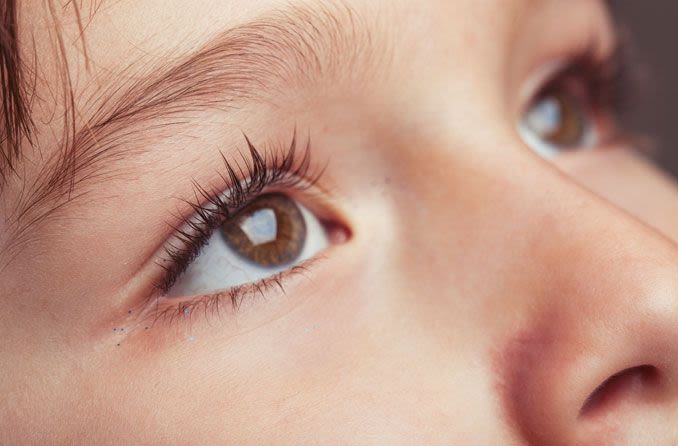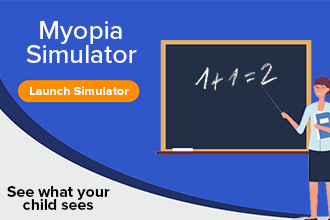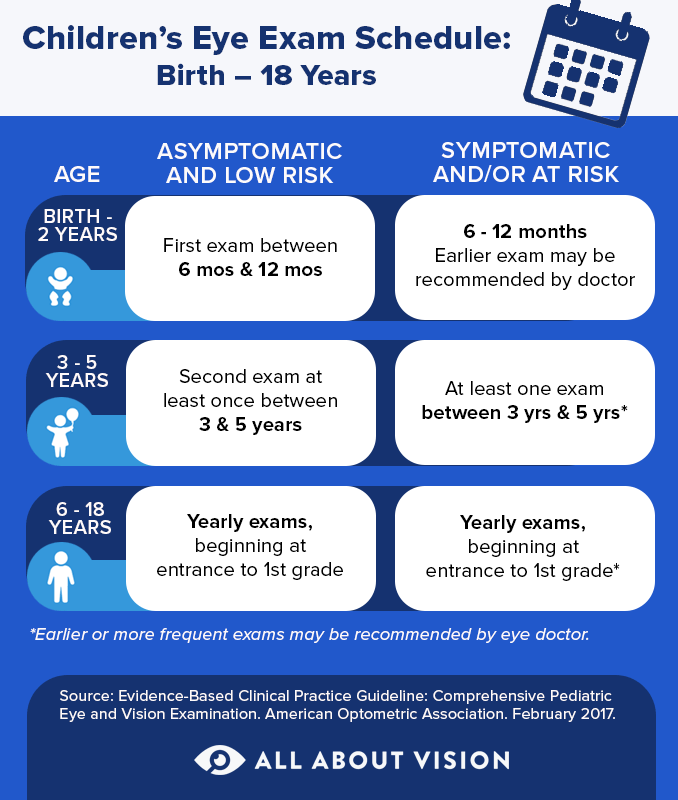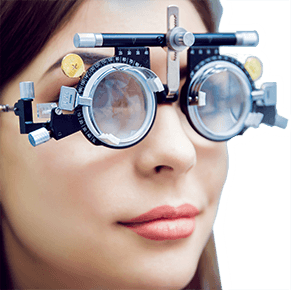Myopia in children: Is your child at risk?

Myopia in kids
Myopia (nearsightedness) is a very common refractive error that causes blurry distance vision. Myopia usually begins in childhood, but it can get worse each year until adulthood. Some of the risk factors for developing myopia as a child include genetics, lifestyle and vision habits.
Nearsightedness can usually be corrected with prescription glasses or contact lenses. However, these standard lenses don’t do anything to slow myopia progression.
Standard single-vision corrective lenses are not effective in controlling myopia progression. Actually, progression is even more likely if the lens prescriptions are too weak or if they are under-prescribed.
Myopia progression means that the blurry vision keeps getting worse. It can lead to high myopia (severe myopia), especially if it's not addressed in childhood. High myopia is a concern because it can lead to even more serious vision conditions in adulthood, including blindness.
It's important to diagnose myopia in early childhood. If it is detected early enough, myopia control strategies can be used to slow progression and avoid high myopia. And not all kids will have obvious symptoms of myopia. This is one reason why regular pediatric eye exams are critical for all kids.
What causes myopia in children?
Parents are often concerned about the causes of myopia and wonder if their kids are at risk. This can be a special concern for parents who are nearsighted themselves.
The exact cause of nearsightedness is not fully understood, but there are a number of known risk factors. A child may be at risk of developing myopia due to one or more of these factors:

Are bookworms more likely to be nearsighted than other children? Some researchers and opticians think so, but the evidence is not clear-cut.
Genetics – If one parent has myopia, the child's risk for myopia is three times greater. If both parents are nearsighted, the child's risk for myopia is double that.
Environmental factors and visual habits are known as "modifiable" risk factors. Unlike genetics, these factors can be easily modified through simple behavior and habit changes.
And they are receiving a lot of attention these days. Research is showing more and more evidence that these “healthier” behaviors can delay the onset of myopia.
Environmental factors – There is strong evidence that not spending enough time outdoors is related to the onset of myopia. Parents should encourage their kids to spend around 2 hours a day outside in natural daylight.
Visual habits – There is also evidence that prolonged near work may lead to myopia. Near work is any task that requires close visual focus, like reading and using digital devices. Holding books or digital screens too close to the eyes for long periods may also increase the risk of myopia.
Parents should encourage their kids to take frequent vision breaks during near work. This is also known as the 20-20-20 rule.
How to reduce your child's risk of myopia
One of the best things to tell your child to reduce their risk of myopia is, "Go outside and play!"
A number of studies show that spending more time outdoors may help prevent or reduce the progression of myopia in children. In fact, there is evidence that outdoor time may have a higher impact than both genetics and time spent doing near work.
Research has found that outdoor exposure to natural sunlight may influence the actual development of the eyes. The most common cause of blurry distance vision is related to the axial length of the eye. This is the length of the eye from front to back, and myopia occurs if it grows too long.
Studies show that outdoor exposure to sunlight (or a lack of exposure) is related to this growth. Children who spend more time outdoors have a lower average growth in the axial length of their eyes.
Outdoor time has also been shown to have a protective effect on myopia risk in children who are not already nearsighted. And it's been shown to reduce the progression of myopia in children who are.
Ensuring that your child receives regular eye exams is also extremely important. Myopia usually begins in childhood, and the peak years of myopia progression are in childhood.
Myopia control strategies are effective, but only if they are used early enough. This is why it's critical that myopia is detected and diagnosed early on. But remember, many kids won't display obvious signs of myopia or complain of symptoms.
Vision experts recommend that all children follow this eye exam schedule:
First eye exam at 6 months
Next exam between ages 3 and 5
Third exam when starting first grade
Annual exams throughout school
If your child has progressive myopia, they will likely need to have eye exams more frequently.
It's also critical to keep up with regular eye exams to ensure your child's vision prescription is up to date. If their lens prescription is too weak for their degree of myopia, it can increase the risk of myopia progression.
Take-home message
Nearsightedness is very common, so it may seem like it's not cause for concern. But childhood myopia, and especially progressive myopia, are definitely things to pay attention to.
If progressive myopia is not managed properly, it can lead to high myopia and other serious vision complications in adulthood.
To reduce your child's risk of myopia and progressive myopia, leading eye experts recommend:
Regular eye exams, starting at 6 months of age
1 - 2 hours per day of outdoor exposure to sunlight
Reduced time spent on non-school related near work
Frequent breaks of 20 seconds or more during all near work
Eye exams are critical for all kids, even if they don't show any signs of a vision problem. Schedule annual eye exams with an eye doctor near you to monitor your child's vision throughout the school years.
Gary Heiting, OD also contributed to this article.
A randomized clinical trial of progressive addition lenses versus single vision lenses on the progression of myopia in children. Investigative Ophthalmology & Visual Science. April 2003.
Undercorrection of myopia enhances rather than inhibits myopia progression. Vision Research. October 2002.
Myopia and associated pathological complications. Ophthalmic and Physiological Optics. August 2005.
High myopia and its risks. Community Eye Health. 2019.
Parental history of myopia, sports and outdoor activities, and future myopia. Investigative Ophthalmology & Visual Science. August 2007.
Myopia prevention and outdoor light intensity in a school-based cluster randomized trial. Ophthalmology. January 2018.
The association between near work activities and myopia in children—a systematic review and meta-analysis. PLOS ONE. October 2015.
Myopia in young adults is inversely related to an objective marker of ocular sun exposure: the Western Australian Raine Cohort Study. American Journal of Ophthalmology. November 2014.
Outdoor activity during class recess reduces myopia onset and progression in school children. Ophthalmology. May 2013.
Effect of day length on eye growth, myopia progression, and change of corneal power in myopic children. Ophthalmology. May 2013.
Outdoor activity reduces the prevalence of myopia in children. Ophthalmology. August 2008.
Page published on Thursday, January 23, 2020
Page updated on Tuesday, April 4, 2023
Medically reviewed on Wednesday, March 30, 2022










